Welcome Unit Discovering Useful Structures 课件(33页) 2024-2025学年高一英语人教版(2019)必修第一册
文档属性
| 名称 | Welcome Unit Discovering Useful Structures 课件(33页) 2024-2025学年高一英语人教版(2019)必修第一册 |  | |
| 格式 | pptx | ||
| 文件大小 | 3.7MB | ||
| 资源类型 | 教案 | ||
| 版本资源 | 人教版(2019) | ||
| 科目 | 英语 | ||
| 更新时间 | 2024-10-09 18:11:26 | ||
图片预览

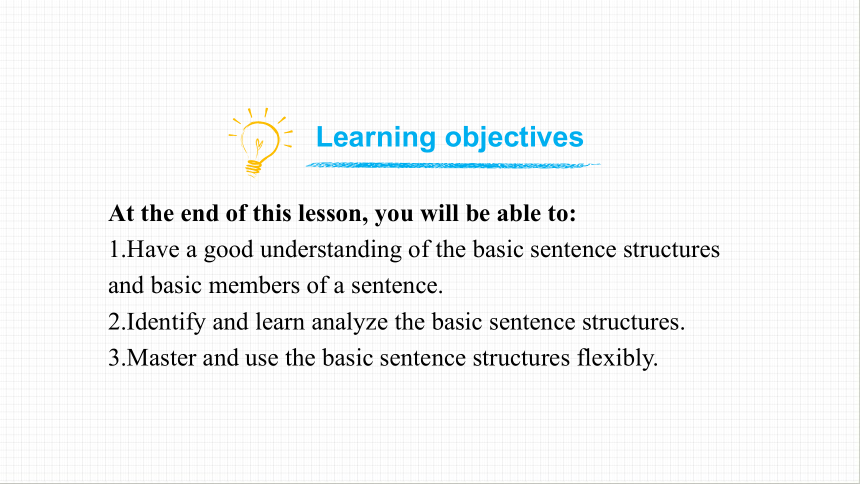
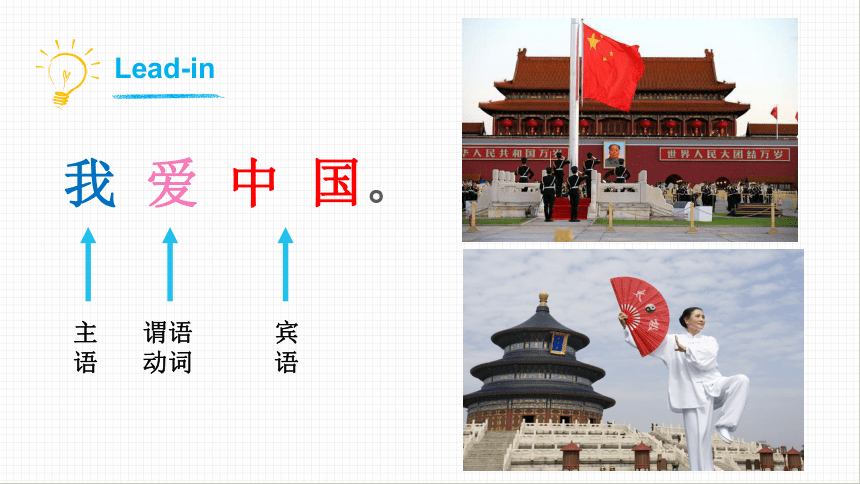
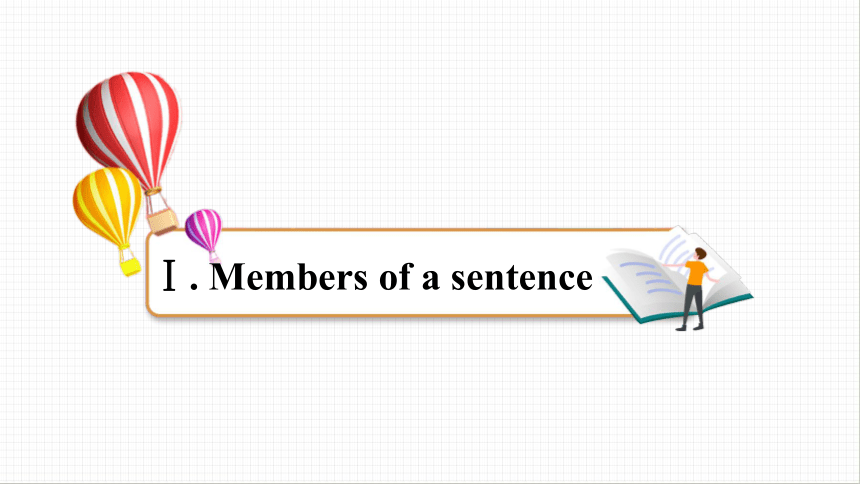
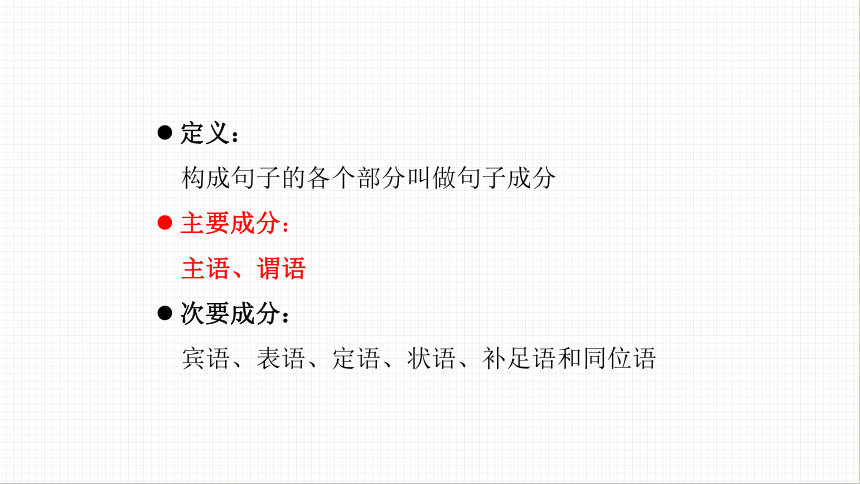
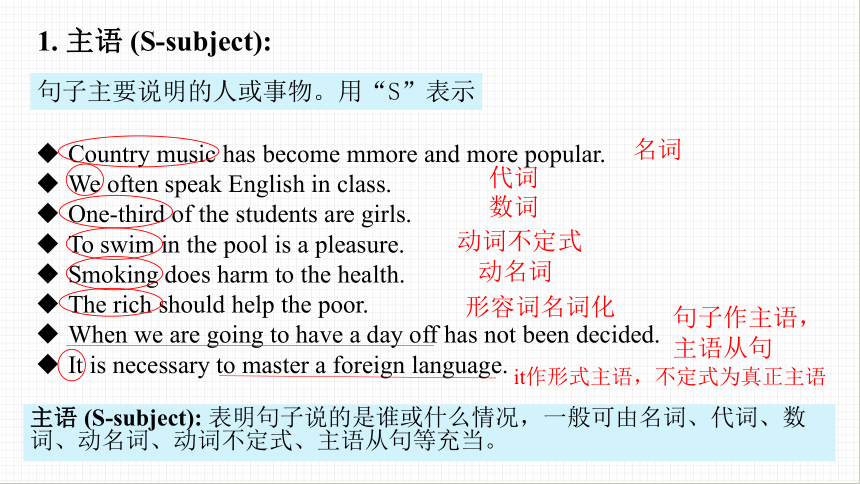
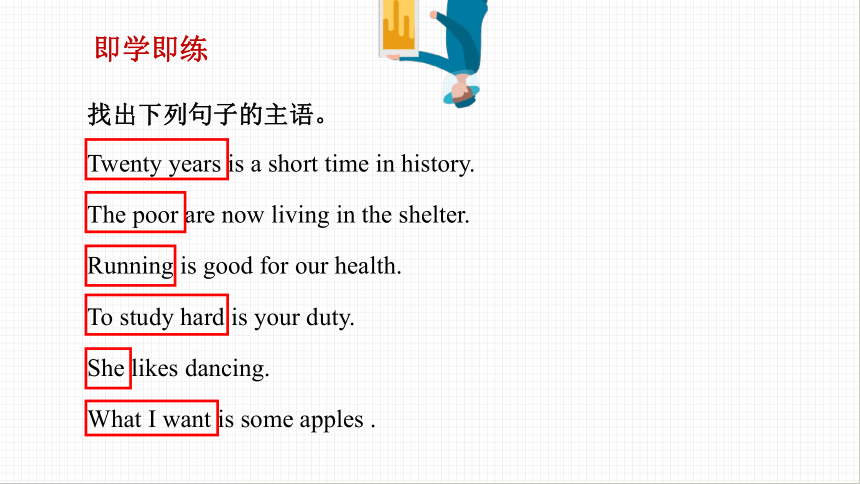
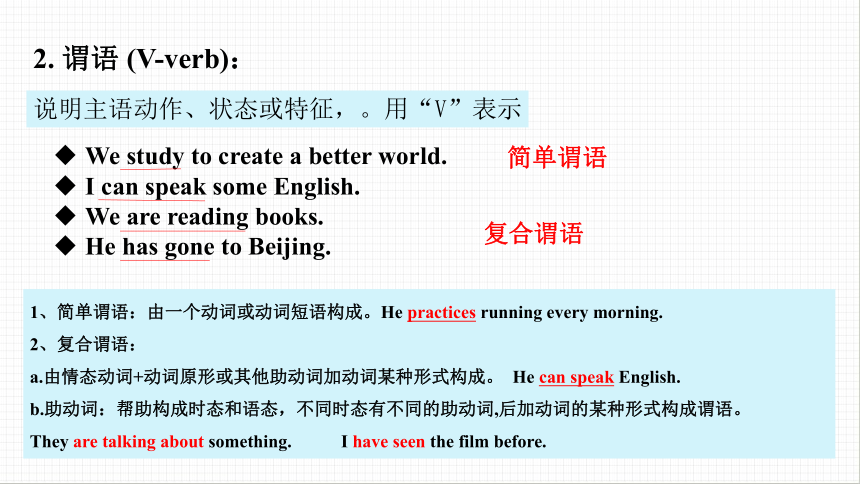
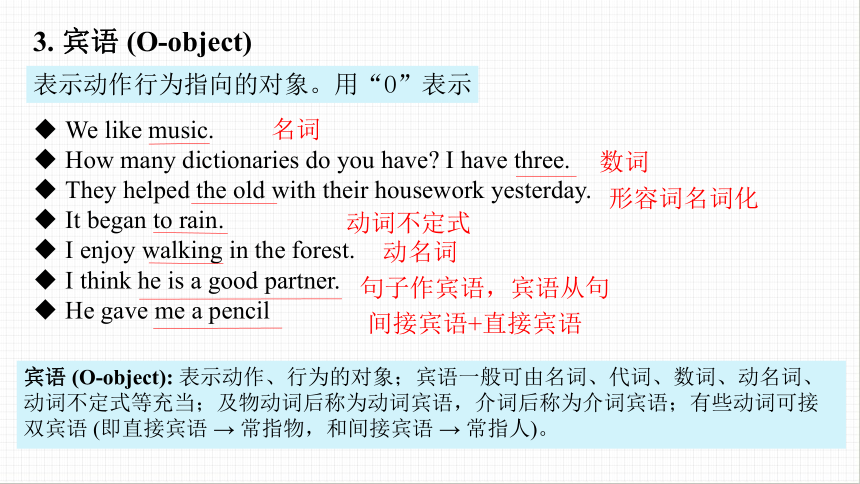
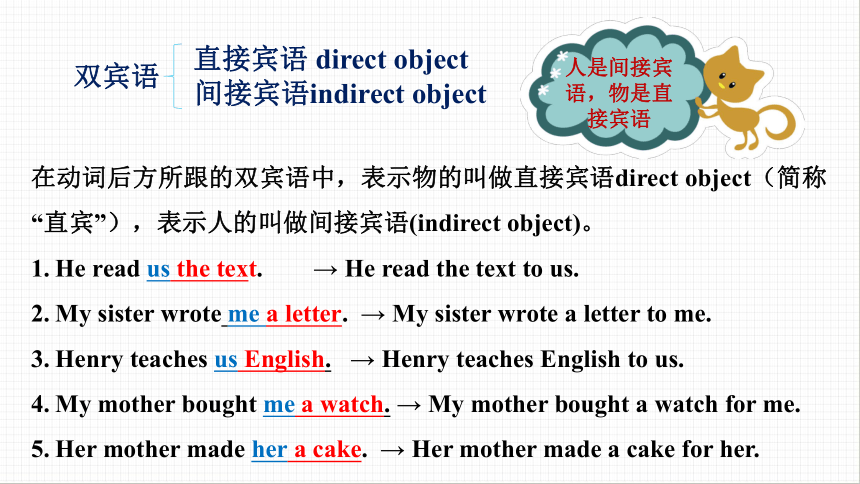
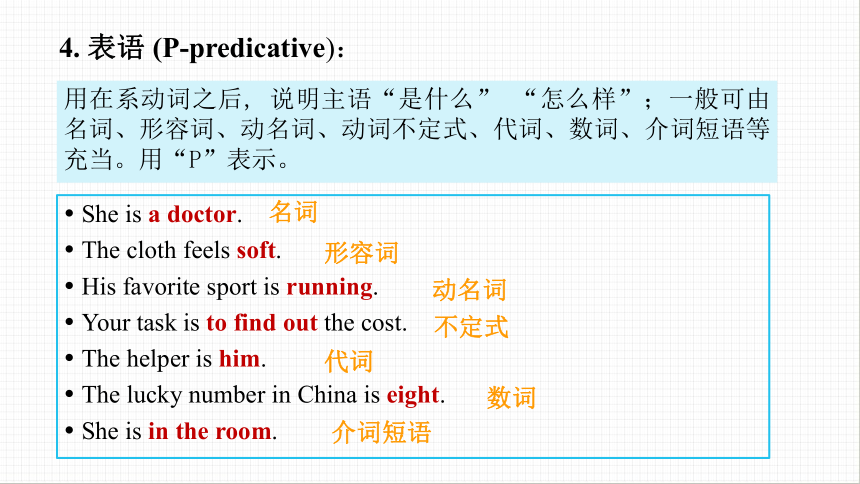
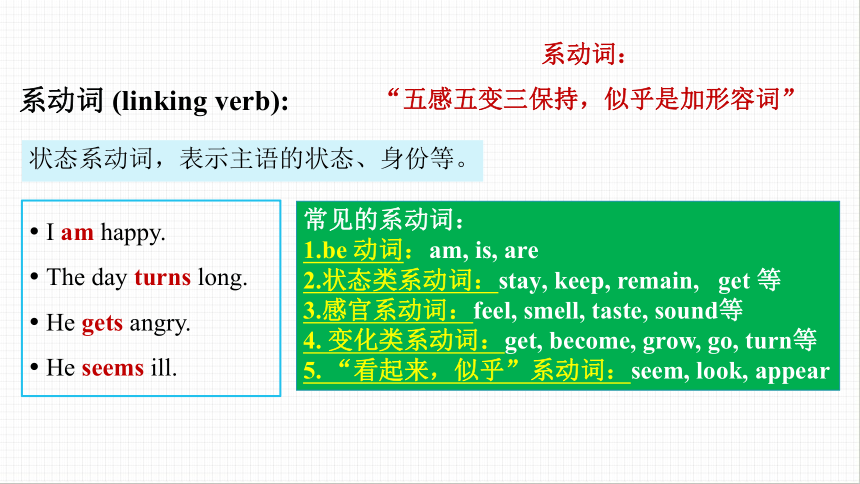
文档简介
(共33张PPT)
Welcome Unit
Discovering Useful Structures
At the end of this lesson, you will be able to:
1.Have a good understanding of the basic sentence structures and basic members of a sentence.
2.Identify and learn analyze the basic sentence structures.
3.Master and use the basic sentence structures flexibly.
Learning objectives
我 爱 中 国。
主语
谓语动词
宾语
Lead-in
Ⅰ. Members of a sentence
定义:
构成句子的各个部分叫做句子成分
主要成分:
主语、谓语
次要成分:
宾语、表语、定语、状语、补足语和同位语
1. 主语 (S-subject):
句子主要说明的人或事物。用“S”表示
Country music has become mmore and more popular.
We often speak English in class.
One-third of the students are girls.
To swim in the pool is a pleasure.
Smoking does harm to the health.
The rich should help the poor.
When we are going to have a day off has not been decided.
It is necessary to master a foreign language.
名词
代词
数词
动词不定式
形容词名词化
动名词
句子作主语,
主语从句
it作形式主语,不定式为真正主语
主语 (S-subject): 表明句子说的是谁或什么情况,一般可由名词、代词、数词、动名词、动词不定式、主语从句等充当。
即学即练
找出下列句子的主语。
Twenty years is a short time in history.
The poor are now living in the shelter.
Running is good for our health.
To study hard is your duty.
She likes dancing.
What I want is some apples .
说明主语动作、状态或特征,。用“V”表示
1、简单谓语:由一个动词或动词短语构成。He practices running every morning.
2、复合谓语:
a.由情态动词+动词原形或其他助动词加动词某种形式构成。 He can speak English.
b.助动词:帮助构成时态和语态,不同时态有不同的助动词,后加动词的某种形式构成谓语。
They are talking about something. I have seen the film before.
We study to create a better world.
I can speak some English.
We are reading books.
He has gone to Beijing.
简单谓语
复合谓语
2. 谓语 (V-verb):
3. 宾语 (O-object)
表示动作行为指向的对象。用“O”表示
We like music.
How many dictionaries do you have I have three.
They helped the old with their housework yesterday.
It began to rain.
I enjoy walking in the forest.
I think he is a good partner.
He gave me a pencil
间接宾语+直接宾语
名词
数词
形容词名词化
动词不定式
动名词
句子作宾语,宾语从句
宾语 (O-object): 表示动作、行为的对象;宾语一般可由名词、代词、数词、动名词、动词不定式等充当;及物动词后称为动词宾语,介词后称为介词宾语;有些动词可接双宾语 (即直接宾语 → 常指物,和间接宾语 → 常指人)。
在动词后方所跟的双宾语中,表示物的叫做直接宾语direct object(简称“直宾”),表示人的叫做间接宾语(indirect object)。
He read us the text. → He read the text to us.
My sister wrote me a letter. → My sister wrote a letter to me.
Henry teaches us English. → Henry teaches English to us.
My mother bought me a watch. → My mother bought a watch for me.
Her mother made her a cake. → Her mother made a cake for her.
直接宾语 direct object
间接宾语indirect object
双宾语
人是间接宾语,物是直接宾语
用在系动词之后, 说明主语“是什么” “怎么样”;一般可由名词、形容词、动名词、动词不定式、代词、数词、介词短语等充当。用“P”表示。
She is a doctor.
The cloth feels soft.
His favorite sport is running.
Your task is to find out the cost.
The helper is him.
The lucky number in China is eight.
She is in the room.
名词
形容词
动名词
代词
不定式
数词
介词短语
4. 表语 (P-predicative):
状态系动词,表示主语的状态、身份等。
I am happy.
The day turns long.
He gets angry.
He seems ill.
系动词 (linking verb):
系动词:
“五感五变三保持,似乎是加形容词”
常见的系动词:
1.be 动词:am, is, are
2.状态类系动词:stay, keep, remain, get 等
3.感官系动词:feel, smell, taste, sound等
4. 变化类系动词:get, become, grow, go, turn等
5. “看起来,似乎”系动词:seem, look, appear
用来修饰或限制名词或代词的成分; 一般可由形容词、非谓语动词、名词、数词、 冠词、介词短语等充当。
a nice girl
three cups
something to eat
a sleeping baby
the burnt food
a cat in the room
a shoe shop
形容词
现在分词
名词
不定式
数词
介词短语
过去分词
5. 定语 (attribute):
He is a clever boy.
His father works in a steel work.
There are 54 students in our class.
Do you known betty’s sister
He bought some sleeping pills.
There is a sleeping baby in bed.
His spoken language is good.
(形容词)
(名词)
(数词)
(名词的所有格)
(动名词)
(现在分词)
(过去分词)
用来修饰动词, 形容词, 副词或整个句子的成分;说明时间、地点、方式、原因、结果、条件、让步、程度、频率、伴随、目的等; 一般可由副词或介词短语充当。用“A”表示
1. How about meeting again at six
2. Last night she didn’t go to the dance party because of the rain.
3. I shall go there if it doesn’t rain.
4. Mr. Smith lives on the third floor.
5. She put the eggs into the basket with great care.
6. She sat there, reading a book.
7. In order to catch up with the others, I must work harder.
8. He was so tired that he fell asleep immediately.
9. she works very hard though she is old.
10. I am taller than he is.
时间
原因
条件
地点
方式
伴随
目的
结果
让步
比较
6. 状语 (adverbial):
7. 宾语补足语 (Object complement):
补充说明宾语。用“C”表示
They elected me captain of the team.
We try to make our country strong.
We found everything in good order there.
I should advise you to get the chance.
I saw him going upstairs.
They found the house broken in.
名词
形容词
介词短语
to do 不定式
现在分词 doing
done 过去分词
Ⅱ. Simple sentence
简单句的定义
The girl is beautiful.
The girl whose name is Liu Yifei is beautiful.
(简单句)
(复合句)
只有一个主语(或并列主语)和一个谓语(或并列谓语)的句子叫作简单句。
The basic sentence structures :
简单句的基本句型
主谓 (SV)
主谓宾 (SVO)
主系表 (SP)
主谓双宾 (S V IO DO)
5. 主谓宾+宾补 (SVOC)
6. 主谓状 (SVA)
7. 主谓宾状 (SVOA)
8. there be …
1. SV 主语+谓语(不及物动词)
注意:有时为了表示发生的频率、原因、结果、目的、地点或时间等,可以有状语来修饰。
不及物动词后面不可直接加宾语。如需要加宾语,需要添加介词
S V (不及物动词)
1. Time 2. The moon 3. We all 4. They 5. He 6. He 7. They flies.
rose.
eat, and drink.
talked for half an hour.
walked yesterday.
is playing.
listens to classical music..
2. SVO 主语+谓语(及物动词)+宾语
此句型中谓语是及物动词,其后必须跟宾语才能使句意表达完整。
S V(实义动词) O(宾语)
1. Who 2. She 3. He 4. He 5. They 6. Danny 7. I 8. He knows laughs at understands made ate likes want said the answer
her.
English.
cakes.
some apples.
donuts.
to have a cup of tea.
"Good morning."
3. SVP 主语+系动词+表语
此类型的句子,谓语动词不能表达一个完整的意思,必须加上一个表明主语性质或状态的表语,才能表达完整的意思。
S V P(表语)
1. This 2. The dinner 3. He 4. Everything 5. He 6. The book 7. The weather 8. His face is smells(闻) fell looks is is became turned an English dictionary.
good.
happy.
different.
tall and strong.
interesting.
warmer.
red.
4. SV IO DO 主语+谓语(及物动词)+间接宾语+直接宾语
常见的可接双宾语的动词有:give, send, bring, owe, take, offer, pass, lend, tell, return, promise, show, write, throw, hand, award, grant等
例2 I bought Tom a birthday gift.
间接宾语
直接宾语
例1 I showed her my photos.
间接宾语
直接宾语
5. SVOC主语+谓语(及物动词)+宾语+宾语补足语
在某些及物动词的后面,需要用一个宾语再加一个宾补才能表达完整的意思。常见的可做宾语补足语的有:名词,形容词,介词短语,动词不定式,不带to的动词不定式等。
常见能够接宾补的动词有:
使役动词:keep, make, let, have, leave, get等;
感官动词或短语:see, watch, notice, observe, find, catch, look at, listen to, hear, feel, smell等;
后跟带to的不定式作宾语补足语的动词:ask, tell, order, request, permit, persuade等。
Mike told me not to go.
The news made everyone of us very happy.
She asked the students their names.
We all heard him reading English aloud.
6. SVA:主语+谓语+状语
They talked for half an hour.
The time passed quickly.
Hopefully, you can take part.
The exhibition will start on 21 June.
此句型的谓语动词通常为不及物动词或不及物动词短语,副词或介词短语在句中作状语,修饰或说明谓语动词。
7. SVOA 主谓宾+状语
在主谓宾句型的基础上补充时间,地点,原因,条件,方式等信息。
I have my first class at senior high school .
状语
8. 存现句(There be ...)
There are three people in my uncle’s family.
There is a pen and two books on the desk.
There isn’t a boy in the room.
There aren’t any books on the desk.
There’s a lot to explore at senior high.
There’s a boy sitting under the tree.
There be ...表示某处存在某物或某人,基本
结构是“There is/ are/ was/ were ...+地点状语”。
1. The 1000-year-old school lies in the centre of the city.
S
Activity 1 Read the sentences and analyse the structures.
V
A
2. We must act.
S
V
3. The maths homework looks easy.
S
P
4. The teacher found the classroom empty.
S
V
O
C
Practice
5. My mum bought me a new dictionary.
S
V
DO
6. Tom is looking forward to meeting the new exchange student.
S
V
7. There is an English Corner at our school.
There be…
8. We had chemistry in the newly built lab.
S
V
O
A
IO
O
他在这家公司上班。
He works in this company.
2. 史密斯先生的话让我印象深刻。
Mr. Smith’s words impressed me.
3. 这个小女孩看起来很害怕。
The little girl seemed/looked frightened.
4. 吉姆明天将去这座岛上探险。
Jim is going to explore this island tomorrow.
SVA
SVO
SP
SVOA
Activity 2 Translate the sentences and analyse the sentence structure.
5. 那个设计者已经给我们发了一封邮件。
The designer has sent us an email.
6. 一切都已经改变了。
Everything has changed.
7. 明天将有一场关于学习策略的讲座。
There will be a lecture on learning strategies tomorrow.
8. 我们必须保持教室干净。
We must keep our classroom clean.
SV IO DO
SV
There be…
SVOC
How would you like to go to school and travel the world at the same time For Tim, that dream has come true! This term, Tim and his classmates are living on a ship! They take the same subjects as you do, like maths and English. They also learn about ships and the sea. Tim writes his parents and email every week and tells them what happened on the ship. Tim loves living on the ship. There’s always something exciting to do. And, after a long day study, he likes to watch the sun go down and wait for the stars to come out. Studying and doing homework seem much more fun when you are at sea!
Activity 3 Read the passage and analyse the structures of the underlined sentences.
SV
SVA
SVO
S V IO DO A
There be...
SVP
V IO DO A
简单句的基本句型
主谓 (SV)
主谓宾 (SVO)
主系表 (SP)
主谓双宾 (S V IO DO)
5. 主谓宾+宾补 (SVOC)
6. 主谓状 (SVA)
7. 主谓宾状 (SVOA)
8. there be …
Summary
Welcome Unit
Discovering Useful Structures
At the end of this lesson, you will be able to:
1.Have a good understanding of the basic sentence structures and basic members of a sentence.
2.Identify and learn analyze the basic sentence structures.
3.Master and use the basic sentence structures flexibly.
Learning objectives
我 爱 中 国。
主语
谓语动词
宾语
Lead-in
Ⅰ. Members of a sentence
定义:
构成句子的各个部分叫做句子成分
主要成分:
主语、谓语
次要成分:
宾语、表语、定语、状语、补足语和同位语
1. 主语 (S-subject):
句子主要说明的人或事物。用“S”表示
Country music has become mmore and more popular.
We often speak English in class.
One-third of the students are girls.
To swim in the pool is a pleasure.
Smoking does harm to the health.
The rich should help the poor.
When we are going to have a day off has not been decided.
It is necessary to master a foreign language.
名词
代词
数词
动词不定式
形容词名词化
动名词
句子作主语,
主语从句
it作形式主语,不定式为真正主语
主语 (S-subject): 表明句子说的是谁或什么情况,一般可由名词、代词、数词、动名词、动词不定式、主语从句等充当。
即学即练
找出下列句子的主语。
Twenty years is a short time in history.
The poor are now living in the shelter.
Running is good for our health.
To study hard is your duty.
She likes dancing.
What I want is some apples .
说明主语动作、状态或特征,。用“V”表示
1、简单谓语:由一个动词或动词短语构成。He practices running every morning.
2、复合谓语:
a.由情态动词+动词原形或其他助动词加动词某种形式构成。 He can speak English.
b.助动词:帮助构成时态和语态,不同时态有不同的助动词,后加动词的某种形式构成谓语。
They are talking about something. I have seen the film before.
We study to create a better world.
I can speak some English.
We are reading books.
He has gone to Beijing.
简单谓语
复合谓语
2. 谓语 (V-verb):
3. 宾语 (O-object)
表示动作行为指向的对象。用“O”表示
We like music.
How many dictionaries do you have I have three.
They helped the old with their housework yesterday.
It began to rain.
I enjoy walking in the forest.
I think he is a good partner.
He gave me a pencil
间接宾语+直接宾语
名词
数词
形容词名词化
动词不定式
动名词
句子作宾语,宾语从句
宾语 (O-object): 表示动作、行为的对象;宾语一般可由名词、代词、数词、动名词、动词不定式等充当;及物动词后称为动词宾语,介词后称为介词宾语;有些动词可接双宾语 (即直接宾语 → 常指物,和间接宾语 → 常指人)。
在动词后方所跟的双宾语中,表示物的叫做直接宾语direct object(简称“直宾”),表示人的叫做间接宾语(indirect object)。
He read us the text. → He read the text to us.
My sister wrote me a letter. → My sister wrote a letter to me.
Henry teaches us English. → Henry teaches English to us.
My mother bought me a watch. → My mother bought a watch for me.
Her mother made her a cake. → Her mother made a cake for her.
直接宾语 direct object
间接宾语indirect object
双宾语
人是间接宾语,物是直接宾语
用在系动词之后, 说明主语“是什么” “怎么样”;一般可由名词、形容词、动名词、动词不定式、代词、数词、介词短语等充当。用“P”表示。
She is a doctor.
The cloth feels soft.
His favorite sport is running.
Your task is to find out the cost.
The helper is him.
The lucky number in China is eight.
She is in the room.
名词
形容词
动名词
代词
不定式
数词
介词短语
4. 表语 (P-predicative):
状态系动词,表示主语的状态、身份等。
I am happy.
The day turns long.
He gets angry.
He seems ill.
系动词 (linking verb):
系动词:
“五感五变三保持,似乎是加形容词”
常见的系动词:
1.be 动词:am, is, are
2.状态类系动词:stay, keep, remain, get 等
3.感官系动词:feel, smell, taste, sound等
4. 变化类系动词:get, become, grow, go, turn等
5. “看起来,似乎”系动词:seem, look, appear
用来修饰或限制名词或代词的成分; 一般可由形容词、非谓语动词、名词、数词、 冠词、介词短语等充当。
a nice girl
three cups
something to eat
a sleeping baby
the burnt food
a cat in the room
a shoe shop
形容词
现在分词
名词
不定式
数词
介词短语
过去分词
5. 定语 (attribute):
He is a clever boy.
His father works in a steel work.
There are 54 students in our class.
Do you known betty’s sister
He bought some sleeping pills.
There is a sleeping baby in bed.
His spoken language is good.
(形容词)
(名词)
(数词)
(名词的所有格)
(动名词)
(现在分词)
(过去分词)
用来修饰动词, 形容词, 副词或整个句子的成分;说明时间、地点、方式、原因、结果、条件、让步、程度、频率、伴随、目的等; 一般可由副词或介词短语充当。用“A”表示
1. How about meeting again at six
2. Last night she didn’t go to the dance party because of the rain.
3. I shall go there if it doesn’t rain.
4. Mr. Smith lives on the third floor.
5. She put the eggs into the basket with great care.
6. She sat there, reading a book.
7. In order to catch up with the others, I must work harder.
8. He was so tired that he fell asleep immediately.
9. she works very hard though she is old.
10. I am taller than he is.
时间
原因
条件
地点
方式
伴随
目的
结果
让步
比较
6. 状语 (adverbial):
7. 宾语补足语 (Object complement):
补充说明宾语。用“C”表示
They elected me captain of the team.
We try to make our country strong.
We found everything in good order there.
I should advise you to get the chance.
I saw him going upstairs.
They found the house broken in.
名词
形容词
介词短语
to do 不定式
现在分词 doing
done 过去分词
Ⅱ. Simple sentence
简单句的定义
The girl is beautiful.
The girl whose name is Liu Yifei is beautiful.
(简单句)
(复合句)
只有一个主语(或并列主语)和一个谓语(或并列谓语)的句子叫作简单句。
The basic sentence structures :
简单句的基本句型
主谓 (SV)
主谓宾 (SVO)
主系表 (SP)
主谓双宾 (S V IO DO)
5. 主谓宾+宾补 (SVOC)
6. 主谓状 (SVA)
7. 主谓宾状 (SVOA)
8. there be …
1. SV 主语+谓语(不及物动词)
注意:有时为了表示发生的频率、原因、结果、目的、地点或时间等,可以有状语来修饰。
不及物动词后面不可直接加宾语。如需要加宾语,需要添加介词
S V (不及物动词)
1. Time 2. The moon 3. We all 4. They 5. He 6. He 7. They flies.
rose.
eat, and drink.
talked for half an hour.
walked yesterday.
is playing.
listens to classical music..
2. SVO 主语+谓语(及物动词)+宾语
此句型中谓语是及物动词,其后必须跟宾语才能使句意表达完整。
S V(实义动词) O(宾语)
1. Who 2. She 3. He 4. He 5. They 6. Danny 7. I 8. He knows laughs at understands made ate likes want said the answer
her.
English.
cakes.
some apples.
donuts.
to have a cup of tea.
"Good morning."
3. SVP 主语+系动词+表语
此类型的句子,谓语动词不能表达一个完整的意思,必须加上一个表明主语性质或状态的表语,才能表达完整的意思。
S V P(表语)
1. This 2. The dinner 3. He 4. Everything 5. He 6. The book 7. The weather 8. His face is smells(闻) fell looks is is became turned an English dictionary.
good.
happy.
different.
tall and strong.
interesting.
warmer.
red.
4. SV IO DO 主语+谓语(及物动词)+间接宾语+直接宾语
常见的可接双宾语的动词有:give, send, bring, owe, take, offer, pass, lend, tell, return, promise, show, write, throw, hand, award, grant等
例2 I bought Tom a birthday gift.
间接宾语
直接宾语
例1 I showed her my photos.
间接宾语
直接宾语
5. SVOC主语+谓语(及物动词)+宾语+宾语补足语
在某些及物动词的后面,需要用一个宾语再加一个宾补才能表达完整的意思。常见的可做宾语补足语的有:名词,形容词,介词短语,动词不定式,不带to的动词不定式等。
常见能够接宾补的动词有:
使役动词:keep, make, let, have, leave, get等;
感官动词或短语:see, watch, notice, observe, find, catch, look at, listen to, hear, feel, smell等;
后跟带to的不定式作宾语补足语的动词:ask, tell, order, request, permit, persuade等。
Mike told me not to go.
The news made everyone of us very happy.
She asked the students their names.
We all heard him reading English aloud.
6. SVA:主语+谓语+状语
They talked for half an hour.
The time passed quickly.
Hopefully, you can take part.
The exhibition will start on 21 June.
此句型的谓语动词通常为不及物动词或不及物动词短语,副词或介词短语在句中作状语,修饰或说明谓语动词。
7. SVOA 主谓宾+状语
在主谓宾句型的基础上补充时间,地点,原因,条件,方式等信息。
I have my first class at senior high school .
状语
8. 存现句(There be ...)
There are three people in my uncle’s family.
There is a pen and two books on the desk.
There isn’t a boy in the room.
There aren’t any books on the desk.
There’s a lot to explore at senior high.
There’s a boy sitting under the tree.
There be ...表示某处存在某物或某人,基本
结构是“There is/ are/ was/ were ...+地点状语”。
1. The 1000-year-old school lies in the centre of the city.
S
Activity 1 Read the sentences and analyse the structures.
V
A
2. We must act.
S
V
3. The maths homework looks easy.
S
P
4. The teacher found the classroom empty.
S
V
O
C
Practice
5. My mum bought me a new dictionary.
S
V
DO
6. Tom is looking forward to meeting the new exchange student.
S
V
7. There is an English Corner at our school.
There be…
8. We had chemistry in the newly built lab.
S
V
O
A
IO
O
他在这家公司上班。
He works in this company.
2. 史密斯先生的话让我印象深刻。
Mr. Smith’s words impressed me.
3. 这个小女孩看起来很害怕。
The little girl seemed/looked frightened.
4. 吉姆明天将去这座岛上探险。
Jim is going to explore this island tomorrow.
SVA
SVO
SP
SVOA
Activity 2 Translate the sentences and analyse the sentence structure.
5. 那个设计者已经给我们发了一封邮件。
The designer has sent us an email.
6. 一切都已经改变了。
Everything has changed.
7. 明天将有一场关于学习策略的讲座。
There will be a lecture on learning strategies tomorrow.
8. 我们必须保持教室干净。
We must keep our classroom clean.
SV IO DO
SV
There be…
SVOC
How would you like to go to school and travel the world at the same time For Tim, that dream has come true! This term, Tim and his classmates are living on a ship! They take the same subjects as you do, like maths and English. They also learn about ships and the sea. Tim writes his parents and email every week and tells them what happened on the ship. Tim loves living on the ship. There’s always something exciting to do. And, after a long day study, he likes to watch the sun go down and wait for the stars to come out. Studying and doing homework seem much more fun when you are at sea!
Activity 3 Read the passage and analyse the structures of the underlined sentences.
SV
SVA
SVO
S V IO DO A
There be...
SVP
V IO DO A
简单句的基本句型
主谓 (SV)
主谓宾 (SVO)
主系表 (SP)
主谓双宾 (S V IO DO)
5. 主谓宾+宾补 (SVOC)
6. 主谓状 (SVA)
7. 主谓宾状 (SVOA)
8. there be …
Summary
